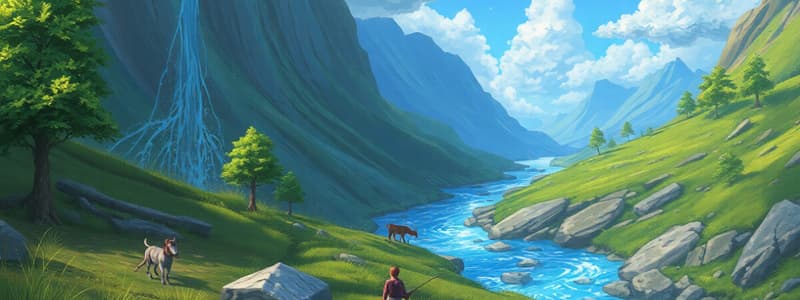Podcast
Questions and Answers
Which of the following best describes the primary driving force behind the continuous circulation of water in the hydrologic cycle?
Which of the following best describes the primary driving force behind the continuous circulation of water in the hydrologic cycle?
- Geothermal activity heating the Earth's core.
- Solar energy causing phase changes in water. (correct)
- The gravitational pull of the moon on Earth's oceans.
- The Earth's magnetic field influencing water polarity.
The transformation of water from a liquid state to a gaseous state is a crucial part of the water cycle. Which of the following processes describes this transformation?
The transformation of water from a liquid state to a gaseous state is a crucial part of the water cycle. Which of the following processes describes this transformation?
- Infiltration
- Precipitation
- Evaporation (correct)
- Condensation
What role do living organisms play in the evaporation phase of the water cycle?
What role do living organisms play in the evaporation phase of the water cycle?
- They absorb water vapor directly from the atmosphere.
- They primarily facilitate condensation by increasing atmospheric humidity.
- They contribute through transpiration (plants) and perspiration (animals). (correct)
- They have no significant impact on the water cycle.
Which of the following conditions is most conducive to condensation?
Which of the following conditions is most conducive to condensation?
What causes water droplets in clouds to eventually fall as precipitation?
What causes water droplets in clouds to eventually fall as precipitation?
How does soil permeability affect the process of infiltration?
How does soil permeability affect the process of infiltration?
How does the water cycle contribute to making water available for use?
How does the water cycle contribute to making water available for use?
What might happen if the rate of evaporation significantly decreased across the globe?
What might happen if the rate of evaporation significantly decreased across the globe?
In what ways do surface features like mountains and forests affect the water cycle?
In what ways do surface features like mountains and forests affect the water cycle?
What is the primary difference between precipitation in warmer areas versus colder areas?
What is the primary difference between precipitation in warmer areas versus colder areas?
How could deforestation in a watershed impact the local water cycle?
How could deforestation in a watershed impact the local water cycle?
If a large area experiences a prolonged drought, which stages of the water cycle would be most immediately affected?
If a large area experiences a prolonged drought, which stages of the water cycle would be most immediately affected?
How might urbanization impact the infiltration process in the water cycle?
How might urbanization impact the infiltration process in the water cycle?
What role do oceans play in the water cycle?
What role do oceans play in the water cycle?
How does the water cycle help remove impurities from water?
How does the water cycle help remove impurities from water?
Which of the following human activities can directly affect the water cycle?
Which of the following human activities can directly affect the water cycle?
How does climate change influence the water cycle?
How does climate change influence the water cycle?
What is the role of groundwater in sustaining surface water bodies during dry periods?
What is the role of groundwater in sustaining surface water bodies during dry periods?
How can changes in land use practices affect the rate of surface runoff?
How can changes in land use practices affect the rate of surface runoff?
If global temperatures continue to rise, what long-term impacts might be expected on the world's glaciers and ice caps, and how would this affect the water cycle?
If global temperatures continue to rise, what long-term impacts might be expected on the world's glaciers and ice caps, and how would this affect the water cycle?
Flashcards
Water Cycle
Water Cycle
The continuous circulation of water on, above, and below the Earth's surface.
Evaporation
Evaporation
The transformation of liquid water into water vapor. In the water cycle, this occurs primarily from bodies of water like oceans and lakes.
Condensation
Condensation
The process where water vapor in the atmosphere cools and changes back into liquid form, creating clouds.
Precipitation
Precipitation
Signup and view all the flashcards
Infiltration
Infiltration
Signup and view all the flashcards
Transpiration
Transpiration
Signup and view all the flashcards
Study Notes
- The water cycle, also known as the hydrologic cycle, is the continuous circulation of water on Earth.
- The cycle involves physical transformations between solid, liquid, and gaseous states due to temperature changes.
- It's a continuous and limitless process with distinct stages.
- Water is essential for all life on Earth.
- The water cycle allows water to circulate through the hydrosphere, making it available for use.
Evaporation
- The process starts with water evaporating from the Earth's surface into the atmosphere.
- Liquid water from oceans and other bodies turns into gas due to sunlight and heat.
- Living things contribute through transpiration (plants) and perspiration (animals).
Condensation
- Water vapor moves through the atmosphere via wind.
- As vapor rises to higher altitudes, cooler temperatures cause it to condense back into liquid.
- This forms water droplets that accumulate in clouds, making them darker as they fill.
Precipitation
- When water droplets in clouds become too large and heavy, they fall as rain.
- In colder areas, precipitation may occur as snow, frost, or hail.
Infiltration
- Water reaching the ground penetrates the soil to become groundwater.
- The amount of infiltration is affected by soil permeability, slope, and plant cover.
- Infiltrated water can return to the atmosphere through evaporation or enter surface water bodies.
Studying That Suits You
Use AI to generate personalized quizzes and flashcards to suit your learning preferences.




